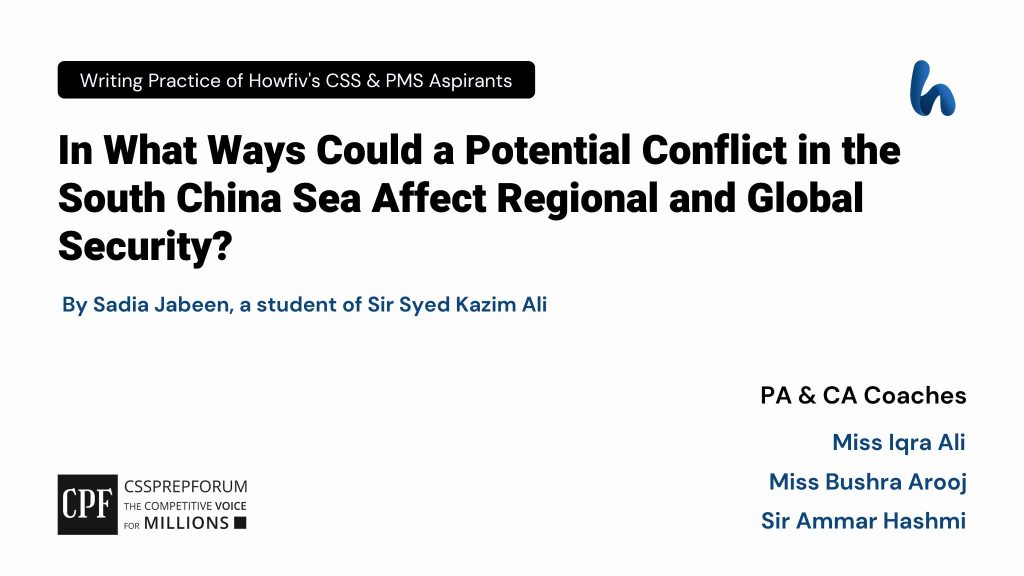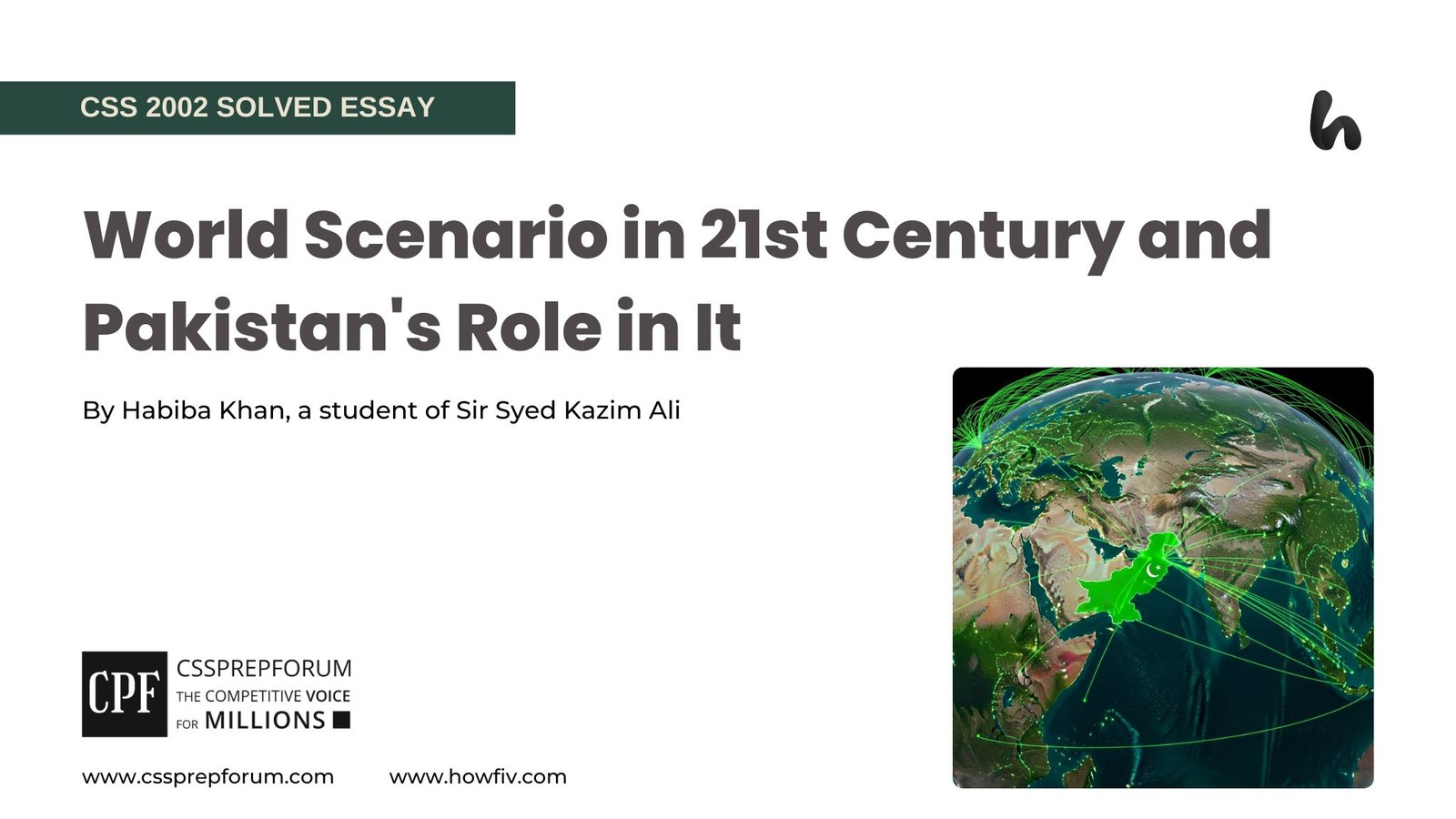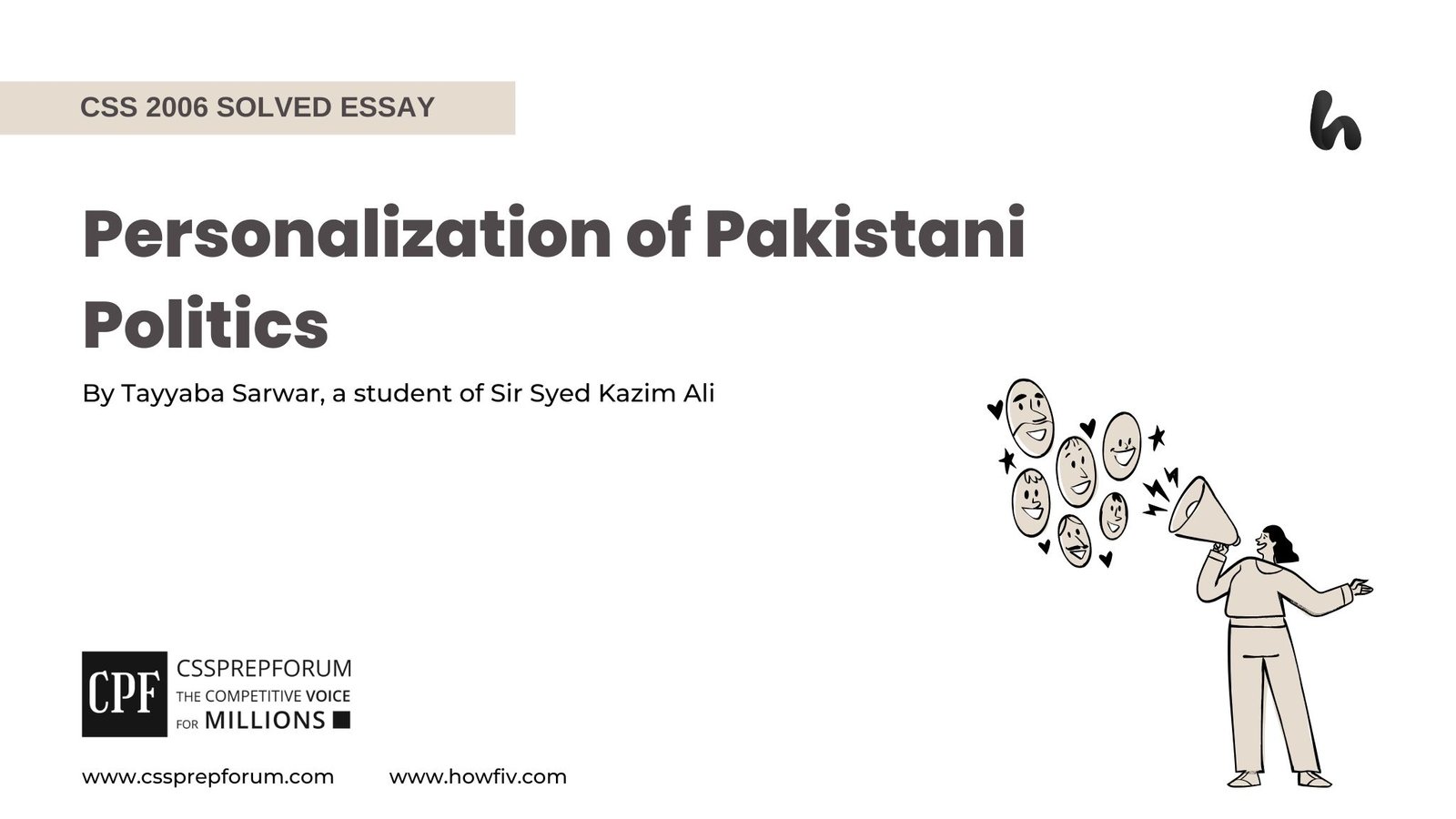CSS Current Affairs | Implications of South China Sea Conflict
The following question of CSS Current Affairs is solved by Sadia Jabeen under the supervision of Howfiv’s Pakistan Affairs and Current Affairs Coaches. She learnt how to attempt 20 marks question and essay writing from Sir Syed Kazim Ali, Pakistan’s best CSS and PMS English essay and precis teacher with the highest success rate of his students. This solved past paper question is attempted on the pattern taught by Sir to his students, scoring the highest marks in compulsory and optional subjects for years, and uploaded to help aspirants understand how to crack a topic or question, how to write relevantly, what coherence is, and how to include and connect ideas, opinions, and suggestions to score the maximum.

Outline
1- Introduction
2- An overview of the South China Sea conflict
3- Ways the South China Sea conflict could affect regional security
- ✓Militarization and tensions
- ✓Food insecurity
- ✓Impacting livelihood
- ✓Environmental damage
4- Ways the South China Sea could affect global security
- ✓Economic instability
- ✓Energy security
- ✓Change in balance of power and global geopolitics
- ✓Increasing danger of global war
5- Possible measures to resolve the South China Sea conflict
- ✓Diplomatic negotiations and confidence-building measures
- ✓Joint development arrangements
- ✓Track two-diplomacy
- ✓Regional cooperation
6- Conclusion

Answer to the Question
Introduction
The South China Sea is one of the most significant shipping routes for global trade. It is also enriched with biodiversity, hydrocarbons, and islands – the Spratlys and the Paracels- that make it economically substantial. States have wrangled over the sea territory for centuries to claim sovereignty over the sea’s natural resources; however, the conflict has grown seriously after China’s claim over a significant portion of the sea. The United Nations Convention on the Law of the Sea (UNCLOS) has tried to resolve the dispute by allowing states to claim 12-nm territorial seas and 200-nm EEZs around their coastline; however, China has rejected the decision. If the South China Sea tensions are not resolved, the potential conflict could seriously affect regional and global security. Nonetheless, any accidental clash between the claimants could escalate a war, severely impacting the region’s peace, food security, livelihoods and natural resources. The conflict could not only affect regional countries but also has the potential to affect the whole globe due to its strategically important location. The military escalation in the South China Sea could disrupt the shipping routes, with economic and security implications. Furthermore, the balance of power and global geopolitics could be changed because of military treaties and an alliance of the regional states with the US and China. Still, an international war could be escalated because of military confrontation in the sea. However, as every cloud has a silver lining, diplomatic negotiations and confidence-building measures, joint development arrangements, track two-diplomacy, and regional cooperation among the states can resolve the South China Sea dispute.
An overview of the South China Sea conflict
The South China Sea dispute is a maritime and island claim among different countries in the region. States involved in the conflict are China, Malaysia, Brunei, the Philippines, Taiwan, and Vietnam. The dispute emerged when China released a map in 1947 showing a nine-dash line in the sea, claiming its historical sovereignty over the sea, especially over the parcel islands. After that, other countries also staked claims in various zones in the sea, like the Smartly and Parcels Islands. The United Nations Convention on the Law of the Sea (UNCLOS) has tried to resolve the dispute by allowing states to claim 12-nm territorial seas and 200-nm EEZs around their coastline; however, China has rejected the decision, which has increased tensions in the region. Since 1947, many serious clashes have been escalated in the region. Recently, in 2023, China and the Philippines had a confrontation in the Sea; The Chinese shone lasers at Filipino boats to temporarily blind their crew and block their path. Furthermore, the dispute has also affected Hollywood; Vietnam banned the Barbie film and Korean pop group Blackpink for promoting Beijing’s nine-dash line.
Ways the South China Sea conflict could affect regional security
- ✓Militarization and tensions
Because of an increasing South China Sea conflict, militarization and an arms race have started among the conflicting countries to assert their sovereignty claim over the sea territory strongly. Nevertheless, Southeast Asian countries are increasing investment in modern fighter aircraft, coastal defence systems, and frigates with anti-submarine, anti-air, and anti-surface capabilities and naval deployments. Additionally, China’s construction of military bases and artificial islands in disputed areas and its assertiveness in the South China Sea has increased tensions with its neighbouring countries, particularly the Philippines and Vietnam, which have raised concerns regarding the risk of confrontation in the sea, which could result in loss of peace in the region.
- ✓Food insecurity
The South China Sea is enriched with biodiversity, including fish, squid, and other seafood. According to estimates, it is one of the world’s top fishing points, with 22% of the world’s fish. Fishing in the sea provides a vital source of food and protein for the local people in the region. Any kind of conflict among the South China Sea-claiming countries could cause food insecurity in the region.
- ✓Impacting livelihood
The South China Sea provides livelihood for millions of people in the region through fisheries, sea route transportation, and tourism. To illustrate, the region’s aquaculture and fishing contribute about $100 billion annually. Additionally, the beautiful islands in the sea, particularly Sansha and Parcel islands, are the major tourist points for attracting surplus by the regional countries. For instance, In 2022, the tourism and travel industry contributed about $241 billion to the GDP of Southeast Asian countries. Potential conflicts could threaten peace and security in the region, impacting the regional population’s livelihood.
- ✓Environmental damage
The South China Sea is enriched with marine biodiversity- home to 115,000 fish and sea creatures, hydrocarbons -190 trillion cubic feet of natural gas and 11 billion barrels of oil- and beautiful rocks and islands. Nevertheless, to capture and claim sovereignty over the natural resources present in the Sea, countries have been increasing militarization in their country. Any confrontation among the claiming countries could lead to war in the region, which could cause environmental damage to the regional natural resources.
Ways the South China Sea could affect global security
- ✓Economic instability
The South China Sea is a significant maritime crossroad for many of the world’s largest economies because 60% of Asian sea route trade and 20% to 33% of Middle East, Africa and the US West Coast maritime trade, which is about one-third of global shipping, passes through it. A high volume of trade through the Strait of Malacca has raised concerns regarding the region’s vulnerability as a strategic checkpoint. A military confrontation: blockades, naval clashes or territorial disputes could affect supply chains in the South China Sea, forcing shipping routes around Australia to increase shipping costs that, ultimately, could impact economic activity across the globe.
- ✓Energy security
Approximately 30% of global maritime gas and oil trade passes through the South China Sea. A potential conflict in the sea could not only cause a potential shortage of energy but also raise oil and gas prices because shipments would need to move through longer paths. Moreover, military confrontation in the region could also damage the gas and oil infrastructure, including energy projects, platforms, pipelines, and storage facilities, which could lead to energy security throughout the globe.
- ✓Change in balance of power and global geopolitics
Among the South China Sea claimant countries, China is economically and militarily more substantial than all other countries due to its actions in the region: naval missions in the sea, artificial island-making, and militarization of islands have raised tensions among other countries. On the other hand, to assert its strategic influence in the region, the US is trying to decrease China’s control over the sea; therefore, some weaker claimant countries of the South China Sea are making alliances with the US. To illustrate, the Philippines has signed a defence treaty with the US; Taiwan and Vietnam are also strong US alliances in the South China Sea region. Apart from sea claimant countries, states of other regions also support the claim of the US and China separately. For instance, Brunei, Mozambique, Slovenia, and Pakistan support China’s resolve. On the contrary, India, South Korea, Australia, Germany, New Zealand, and the UK support the US’s stance on the dispute. So, it clearly shows that the dispute could Change the balance of power and geopolitics throughout the globe.
- ✓Increasing danger of a global war
China’s rejection of the United Nations Convention on the Law of the Sea (UNCLOS), increasing militarization, and alliances with the US to counter China’s influence have increased tensions in the South China Sea. The states misjudged each other’s intentions and actions so they could indulge in military confrontation; the alliance states of the disputed parties, particularly the US, if drawn into a direct military confrontation, could escalate into a global war impacting the globe.
Possible measures to resolve the South China Sea conflict
- ✓Diplomatic Negotiations and Confidence-Building Measures
To resolve the South China Sea, Encourage dialogue among claimant countries: China, Philippines, Vietnam, etc., should encourage dialogue to find common ground. Moreover, confidence-building measures, like joint resource exploration, could also reduce tensions by fostering trust among the countries.
- ✓Joint Development Arrangements
Claimant states could negotiate joint development of disputed areas by focusing on resource sharing instead of sovereignty. Similar to the ones between Thailand and Malaysia, fishing agreements or joint oil and gas exploration could also be established among the countries of the South China Sea.
- ✓Track Two Diplomacy
Non-governmental organizations can facilitate a ‘Track Two Tribunal’ for collecting evidence, testing legal arguments, and presenting likely outcomes of international court hearings before the claimant countries and their public. This approach can help in understanding and building consensus among the involved states
- ✓Regional cooperation
Strengthening the ASEAN’s role could help promote regional stability by mediating disputes. For this purpose, Southeast Asian countries should recognize and understand each other’s de facto occupation of specific features and present a united front to China. This would increase cooperation within the organization by reducing competition among ASEAN members.
Conclusion
The South China Sea conflict has been posing severe risks to regional stability, the security of neighbouring states, and international norms. Simultaneously, its global implications could affect energy security, economies, and international relations. But, diplomatic efforts and cooperation are crucial to preventing further escalation. However, compromise, patience, and sustained efforts from all claimant countries are required to achieve long-lasting peace.

CSS Solved Past Papers’ Essays
Looking for the last ten years of CSS and PMS Solved Essays and want to know how Sir Kazim’s students write and score the highest marks in the essays’ papers? Then, click on the CSS Solved Essays to start reading them.
CSS Solved Essays
CSS Solved Islamiyat Past Papers
Want to read the last ten years’ Islamiyat Solved Past Papers to learn how to attempt them and to score high? Let’s click on the link below to read them all freely. All past papers have been solved by Pakistan’s top CSS Islamiyat coach having the highest score of their students.
CSS Solved Islamiyat
CSS Solved General Science & Ability Past Papers
Want to read the last ten years’ General Science & Ability Solved Past Papers to learn how to attempt them and to score high? Let’s click on the link below to read them all freely. All past papers have been solved by Pakistan’s top CSS GSA coach having the highest score of their students.
CSS Solved General Science & Ability












